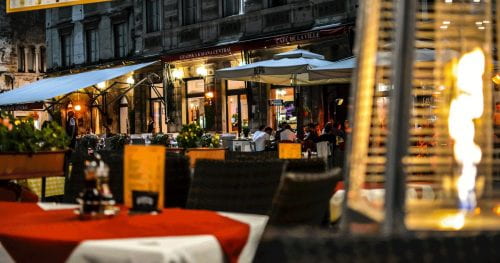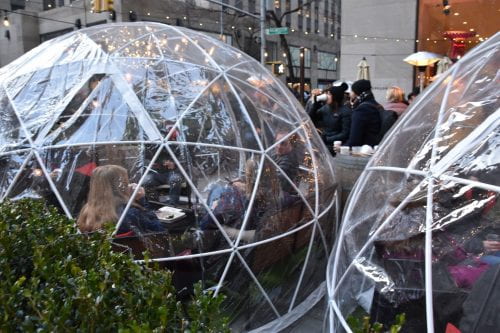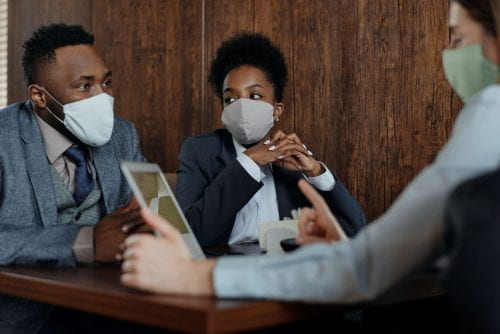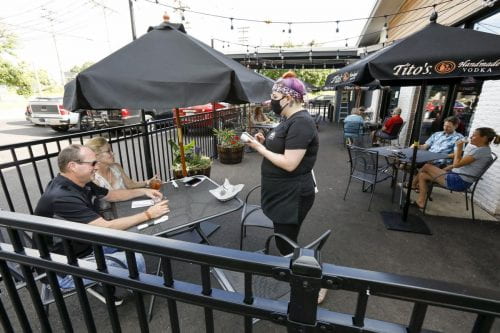
Across the US, the onset of colder temperatures is sending shivers up the spines of restaurant owners. For many, outdoor dining has been a saving grace during the COVID-19 pandemic. In New York City alone, an estimated 100,000 jobs have been saved with the expansion of outdoor dining through the Open Restaurants Program, which began in June, with Phase II of the city’s reopening strategy.1 This is set amidst a depressing backdrop. A September 2020 survey by the National Restaurant Association revealed that approximately 100,000 restaurants across the US have closed permanently or indefinitely since the onset of the pandemic, leading to a loss of about 3 million jobs nationwide.9 Nationwide sales at eating and drinking establishments were $55.6 billion in September, a significant drop from the pre-pandemic February sales of $65.4 billion, but still a critical part of the economic success of cities and states across the country.12 Restaurant dining protocols and regulations have been highly variable across cities and states since March. While many governments have increasingly permitted limited indoor dining, most restaurants currently rely on some combination of indoor spaces, outdoor dining, takeout, pickup, and delivery. This choice is largely determined by access to space for outdoor dining, clientele, type of cuisine, and costs and time involved in the permitting process. Winter temperatures and precipitation present a challenge to space, safety, and cost of outdoor dining experiences, and ultimately the survival of the restaurants.
There are a number of logistical considerations for outdoor dining in the winter months, including snow removal, high winds, extended ADA considerations, heating needs, and the structural ability of the tent or enclosure to hold the weight of snow without collapsing.2 These hurdles will vary with each city’s climate, but even in warmer parts of the country, winter nights are too chilly for most diners. As Fares Kargar, a restaurant owner in Atlanta, Georgia, notes, “Nobody wants to sit outside… With the cold season coming, I am working on getting the patio fully covered”.5 The set-up varies from one restaurant to the next, as do the challenges associated with each individual space. Some have the benefit of existing patio and outdoor dining space; others have featured tents and igloos so they are accessible even in cities with variable weather like Detroit.7
Stark increases in demand for the necessities of cold-season, outdoor dining- including heat lamps, tents, igloos, and other solutions- have coincided with long lead times and increased costs. As a restaurant owner, just navigating the available options and making a decision on which direction to proceed can be difficult. The New York City Open Restaurants program guidelines provide insight into the types of options available, depending on the type of outdoor dining setup. Electric radiant, natural gas radiant, and portable propane heaters are all permissible for sidewalk seating, but electric radiant is the only option for roadway/parklet seating in the city.3 Electric radiant heaters are generally the most popular outdoor heating option because they are more portable than natural gas heaters, cost less upfront, and are the safest option for use in enclosed or covered spaces. Ongoing costs associated with each option, from propane tanks to utility bills, add to the monthly expense burden faced by restaurant operators.10 Heaters, along with other winterization items, are just a portion of the thousands of dollars restaurant owners have spent to address the realities of dining during COVID-19. Other investments include partitions, HVAC and air purification systems, and expansion or creation of outdoor dining spaces.5 Grant funding and the elimination or reduction of city permitting costs have eased the burden for many in the short-term, but reduced capacity and patronage have led to tighter cash flows for many restaurants since the pandemic began. As noted by a restaurant owner in Iowa, “It’s more and more and more and more cost that gets pulled into it…a business has got to work out whether an investment in outdoor heating or a vestibule is going to get them the return” (Des Moines Register, 17 Oct. 2020). 8 For many, a decision not to invest in outdoor dining has forced a move to pickup and delivery options only, or resulted in a temporary or permanent closure, a problem that will likely be amplified as colder weather approaches.
As noted in Slate, there was a sharp increase in demand for heat lamps beginning even in the spring and summer months, typically a low point in the heating industry. Many cities and fire departments eased their regulations governing this type of setup in order to drive the success of their outdoor dining initiatives. Manufacturers, distributors, and installers all faced new challenges to their businesses during COVID, including the need to stagger shifts on their shop floors and to extend shipping timeframes. Additionally, residential demand increased as remote workers limited their travel and attempted to improve their at-home experience. As a result of this surge in demand, and the pressures experienced by the global manufacturing sector, heat lamps are difficult to come by. Their installation can present further issues. Slate notes, “the more heaters you cram on a restaurant patio, the fewer customers you can serve, and the harder it might be to make enough money to stay in business”. Winterizing their outdoor dining areas could as much as halve the capacity of this space for restaurants. 6
While restaurant owners grapple with long lead-times on heat lamps, tents, and other items, some US cities are using design competitions to generate creative ideas for outdoor dining during the winter. The city of Chicago initiated their competition in August. One of the winners adapted the Kotatsu, a traditional heated table common in Japan, for use with typical restaurant-style tables. In the design, existing tables are retrofitted with heating elements on the underside of the tables, which then trap the heat. As David L. Howell, a professor of Japanese history at Harvard described, “Traditionally, in Japan, they would heat the body instead of heating the air”1 — a concept that could prove efficient in Chicago, a city with notoriously bitter winters. This model, along with other finalists, will be used as a prototype pilot in Chicago, sponsored by the Illinois Restaurant Association. The food delivery app DoorDash is another sponsor, as part of their $2 million in grants for restaurant winterization in cities across the nation.1 An increasingly creative approach to outdoor dining benefits not only restaurants, but also patrons and the city itself.
Winterization challenges are set against a backdrop of unstable economics for both restaurant operators and landlords since the onset of the COVID-19 pandemic. Restaurants have struggled to pay rent due to reduced patronage and restricted occupancy since March, a common issue among tenants ranging from retail giants to single-family residential renters. Across the country, various responses by both landlords and tenants have produced a wide range of results. Many of the 100,000 restaurants that have shuttered since March cited an inability to pay rent or renegotiate with their landlords. While many landlords have pursued evictions and legal action, others have deferred rent, eliminated it, or reduced it. An additional approach taken by some has been a percentage rent strategy. “A number of landlords are offering concessions for restaurants and other hospitality businesses in the form of percentage-only rent. Some restaurants landlords are temporarily switching from fixed-rate rents to rents based only on a share of tenant’s gross sales or revenues, in an effort to help these businesses survive (US Official News, 30 Sept. 2020).”12 By pursuing this temporary adjustment to the rental agreement, landlords are able to collect some rental income and encourage restaurants to remain open, while operators avoid litigation and reduce their operating costs. Many of the most successful arrangements involve compromise and recognize the hardships of doing business in the pandemic era. Forcing out defaulting tenants may be an effective strategy in a competitive real estate market, but there is currently such limited demand for new restaurants that many landlords have concluded that some rent is better than no rent, and certainly better than a vacant, idle building. This is in addition to regulatory tenant protections in places like New York City, where the commercial eviction moratorium has been extended to January 1, 2021, the fourth such extension since its implementation.11
The issues surrounding outdoor dining in winter conditions will only continue as weather worsens. For patrons looking to support local businesses and eat outside their homes, the creativity associated with the expansion and winterization of outdoor dining has been a highlight of the pandemic. Many restaurant owners have experienced significant success with outdoor dining during the summer and fall, but the cost and logistical hurdles of winterizing these spaces may present a challenge for even the most adept. Regardless, a mix of outdoor dining, indoor dining, and takeout will have to be the strategy for many restaurants this winter.4
Across the country, cities continue to support outdoor dining as part of a strategy for economic recovery. Temporary or permanent restaurant closures increase the strain on public finances (including unemployment and food stamps), create additional vacant and abandoned properties, and negatively impact the collection of business and real estate taxes. Continued streamlining and low-cost permitting, grants for winterization costs, and eviction moratoriums are some of the best practices for ensuring continued restaurant operations throughout the winter months. Many cities are currently facing a resurgence in COVID-19 cases, likely stalling plans to reopen or expand indoor dining options. The lessons learned from installing and operating these outdoor spaces, as well as dining in them, are sure to be of use for many winters to come, regardless of the status of COVID-19.
End Notes
- “Japan’s unique heated tables may be the solution to winter outdoor dining for Chicago restaurants.” The Business Insider, 25 Oct. 2020, p. NA. Gale Academic OneFile, https://link.gale.com/apps/doc/A639365409/AONE?u=nysl_sc_cornl&sid=AONE&xid=983877d3. Accessed 25 Oct. 2020.
- “Fall and winter outdoor dining guidance.” US Official News, 30 Sept. 2020, p. NA. Gale OneFile:News, https://link.gale.com/apps/doc/A637227755/STND?u=cornell&sid=STND&xid=57014376. Accessed 24 Oct. 2020.
- “Recovery Agenda: New York City Releases Winter Outdoor Dining Guidance.” US Official News, 15 Oct. 2020, p. NA. Gale OneFile: News, https://link.gale.com/apps/doc/A638687452/STND?u=cornell&sid=STND&xid=6ddc3cdf. Accessed 18 Oct. 2020.
- Outdoor dining helped restaurants survive the summer, but Maine’s winter will be a new test.” Bangor Daily News [Bangor, ME] 16 Oct. 2020: NA. Business Insights: Essentials. 20 Oct. 2020.
- Ligaya, F., Ligaya Figueras. “DINING THIS WINTER: Restaurants prepare to dress for cold weather: Outdoor dining takes hold as temperatures begin to fall.” Atlanta Journal- Constitution [Atlanta, GA] 11 Oct. 2020: ET. Business Insights: Essentials. 25 Oct. 2020.
- Mak, Aaron. “Heat Spots”. Slate, 02 Sep. 2020. https://slate.com/business/2020/09/restaurants-heaters-shortage-coronavirus.html, accessed 20 Oct. 2020.
- “How outdoor dining in the pandemic era is adapting to the colder weather.” CBS This Morning, 14 Oct. 2020, p. NA. Gale OneFile: News, https://link.gale.com/apps/doc/A638462003/STND?u=cornell&sid=STND&xid=a4145c9a. Accessed 20 Oct. 2020.
- “Restaurants worry as outdoor dining faces icy Iowa winter.” Des Moines Register, 17 Oct. 2020, p. NA. NewsBank, https://infoweb-newsbank-com.proxy.library.cornell.edu/apps/news/document-view?p=AWNB&docref=news/17E11BE9CF295CE8, accessed 20 Oct. 2020.
- “Winter is coming, and restaurants worry about outdoor dining challenges.” The Santa Fe New Mexican, 11 Oct. 2020, p. NA. NewsBank, https://infoweb-newsbank-com.proxy.library.cornell.edu/apps/news/document-view?p=AWNB&docref=news%2F17E1151A9B9708B8, accessed 29 Oct. 2020.
- “Patio Heaters: 5 Things You Should Know Before You Buy.” https://transblue.org/patio-heaters-what-you-should-know/, accessed 10 Nov 2020.
- “New York extends eviction moratorium for restaurants through January 1.” Eater New York, 21 Oct. 2020, p. NA. https://ny.eater.com/2020/10/21/21525241/nyc-restaurant-eviction-moratorium-january-1-cuomo, accessed 10 Nov. 2020.
- “Growing Number of Landlords are Offering Restaurants Percentage-Only Rent.” FIP Commercial, 28 Oct. 2020, p. NA. https://fipcommercial.com/growing-number-of-landlords-are-offering-restaurants-percentage-only-rent/, accessed 10 Nov. 2020.




